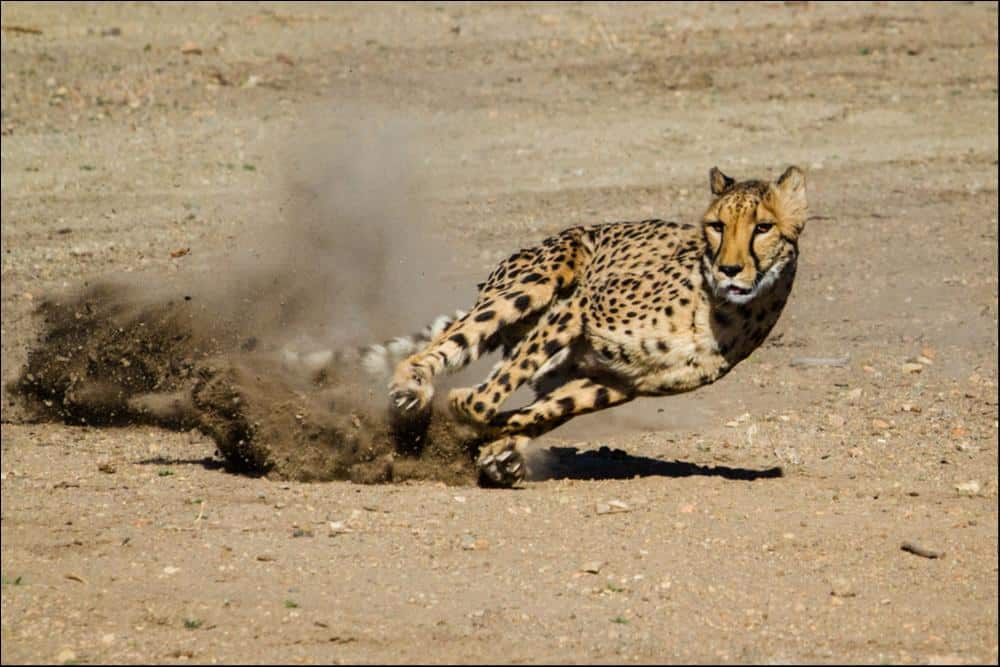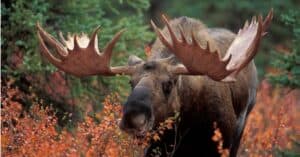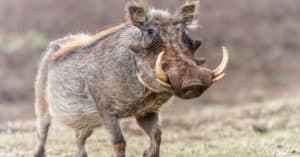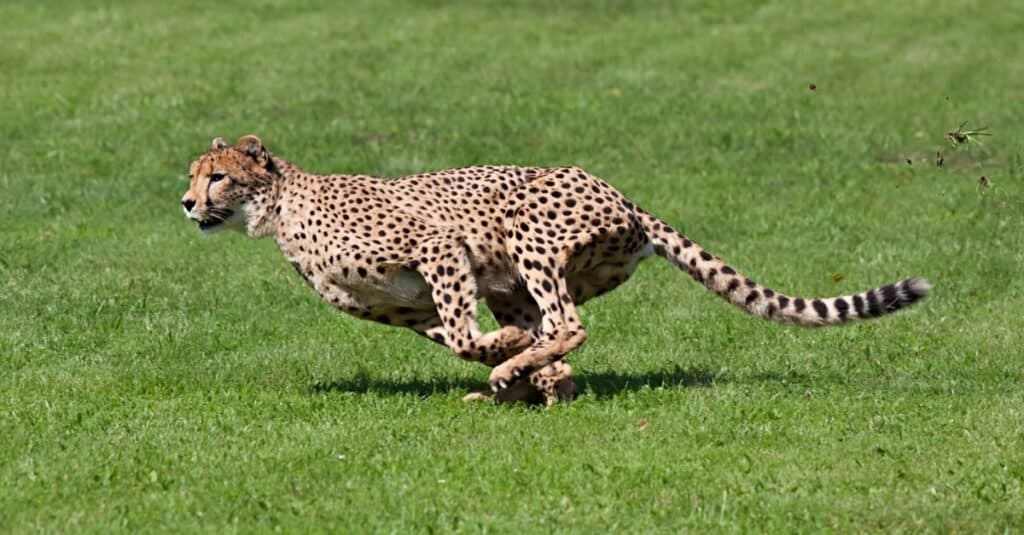
Cheetahs are the planet’s fastest land animal and are built for super speed, rather than stamina.
©Maros Bauer/Shutterstock.com
In terms of ground speed, the cheetah is unrivaled. A cheetah can reach speeds of 69–75 miles per hour. Unfortunately, the cat’s sprinting distance is only about 0.28 miles. Comparatively, a cheetah is around 2.7 times faster than the quickest human runner.
The cheetah’s rapid acceleration allows it to quickly close the gap and catch its prey. In contrast, there are species, primarily birds, which can reach top speeds greater than those of the Cheetah. This piece will discuss 10 creatures that are faster than a Cheetah!
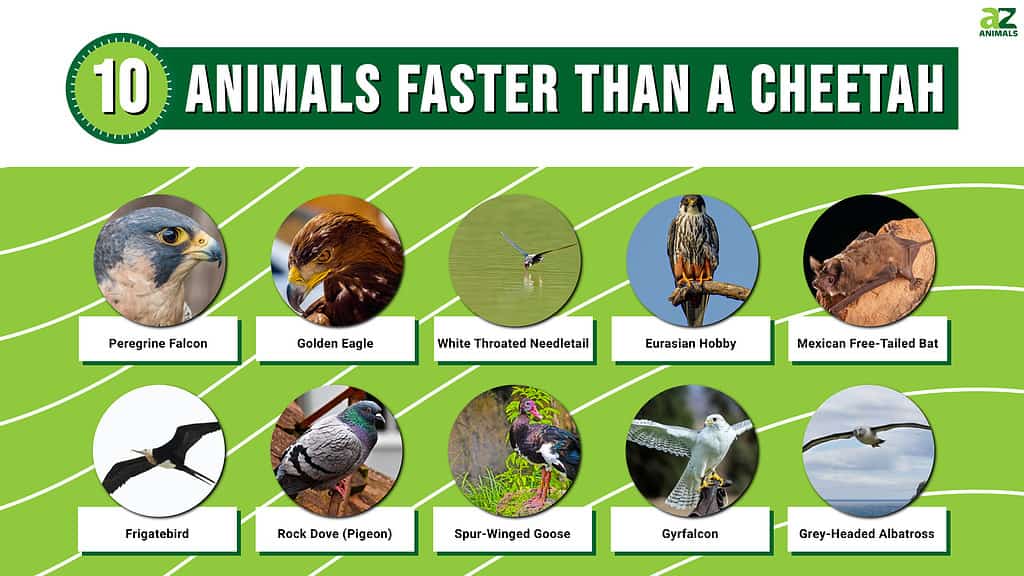
Peregrine Falcon
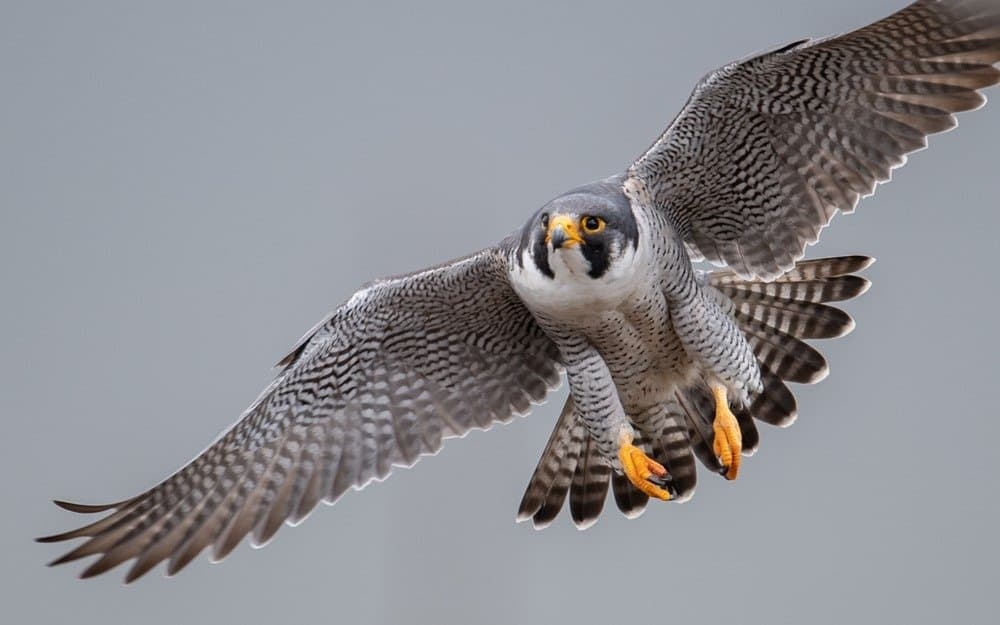
The
Peregrine falcon
may reach speeds of nearly 200 miles per hour.
©Harry Collins Photography/Shutterstock.com
The Peregrine falcon holds the record for fastest flying animal and fastest animal in the animal kingdom. The peregrine falcon’s fastest speed is not reached during a straight-and-level flight but rather during its signature hunting stoop or vertical flight.
The peregrine falcon may reach speeds of nearly 200 miles per hour (320 kilometers per hour) during a stooping dive.
Golden Eagle
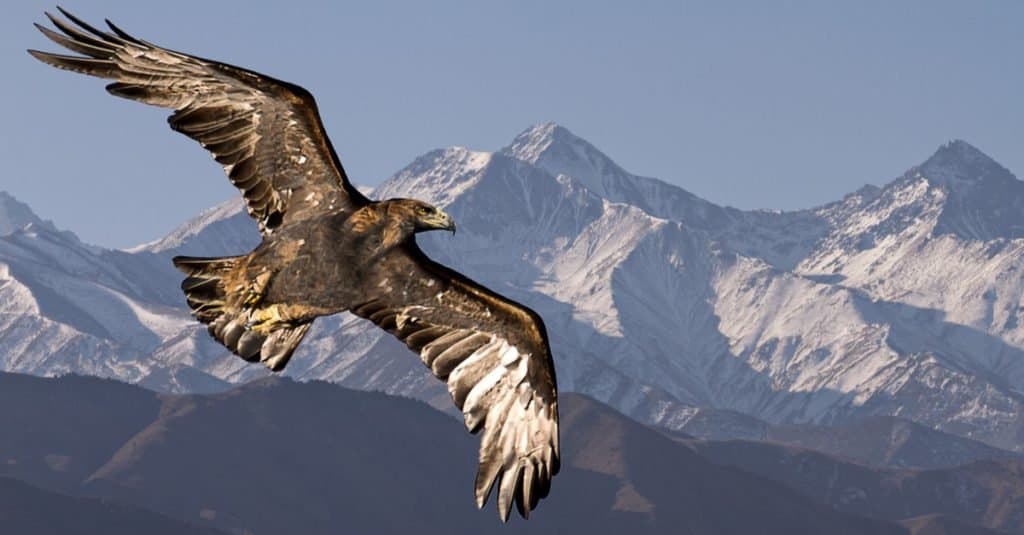
When in flight, a
Golden Eagle
can achieve speeds of around 32 miles per hour.
©MehmetO/Shutterstock.com
When in flight, a Golden Eagle can achieve speeds of around 32 miles per hour, which is rather astounding. They are already astonishingly swift, but when they’re on the hunt they reach new heights of speed. These beautiful birds have been clocked gliding at 120 miles per hour while diving at 150 miles per hour in pursuit of their prey!
The White-Throated Needletail
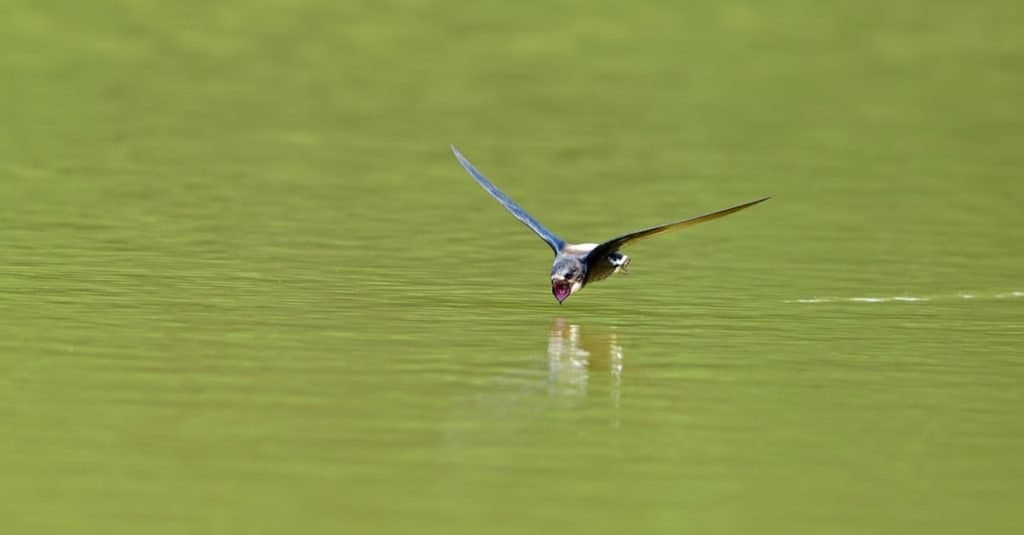
The White-throated Needletail can supposedly travel at a horizontal speed of 170 kilometers per hour or 105 miles per hour.
©scott mirror/Shutterstock.com
The white-throated needletail, also known as Hirundapus caudacutus, is a big swift that is part of the genus Hirundapus. It is also known as the needle-tailed swift and the spine-tailed swift. It can supposedly travel at a horizontal speed of 170 kilometers per hour or 105 miles per hour.
Eurasian Hobby
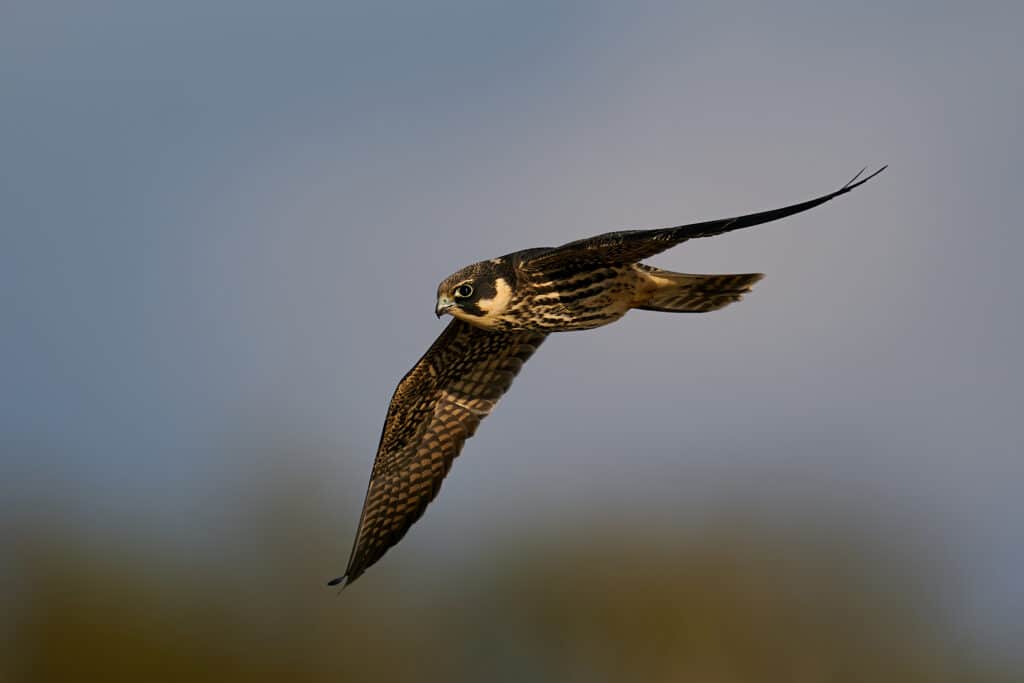
Eurasian hobby in flight in its natural environment in Denmark
©iStock.com/denja1
The Eurasian Hobby is a member of the Falcon family and can reach speeds of 100 miles per hour during the flight. The Eurasian Hobby is unique among birds because of its acrobatic flight, which enables it to change its wings’ shape and size depending on its speed and to perform high dives to catch its prey. At its fastest, it can go at a rate of 160 kilometers per hour or about 100 miles per hour.
Mexican Free-Tailed Bat
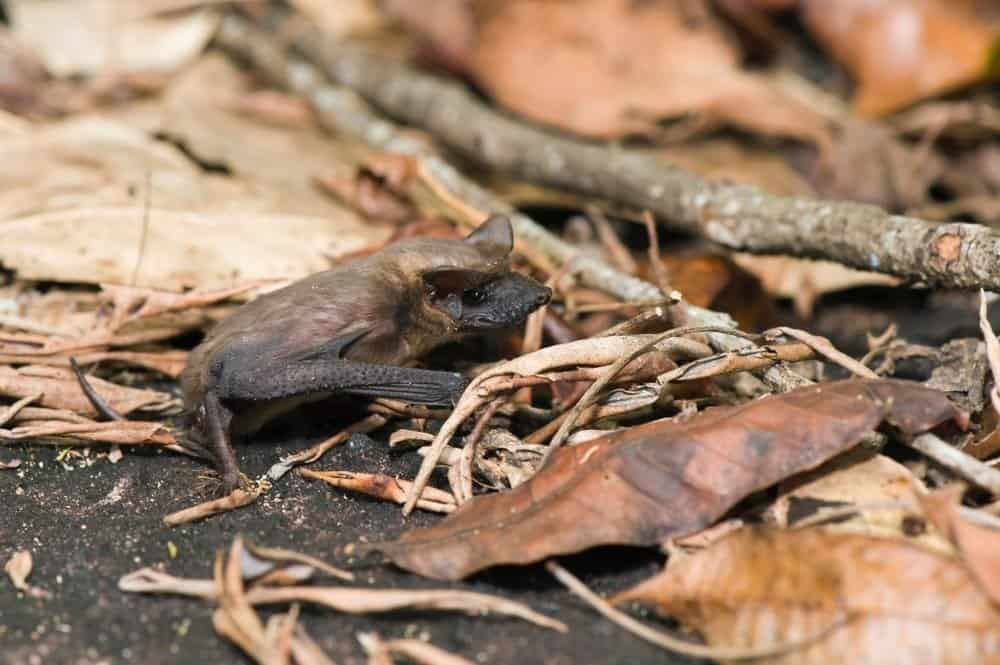
A Mexican free-tailed bat is reported to attain ground speeds of exceeding 100 mph, or 161 km/h, making it the fastest mammal in terms of horizontal speed.
©GTW/Shutterstock.com
The Mexican free-tailed bat, a species of medium-sized bat endemic to the Americas, is often considered to be one of the continent’s most plentiful animals. It is reported to attain ground speeds of exceeding 100 mph, or 161 km/h, making it the fastest mammal in terms of horizontal speed, as opposed to its stoop diving speed.
Frigatebird
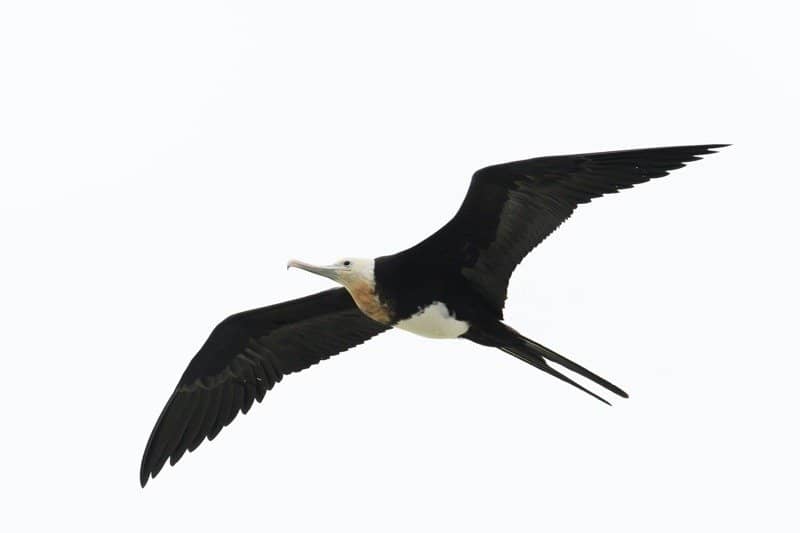
Frigatebirds may reach speeds of up to 95 miles per hour or 135 km/h.
©rock ptarmigan/Shutterstock.com
Fregatidae is a family of seabirds that includes colorful and regal frigatebirds. This single genus, Fregata, is home to five distinct species. Man-o’-wars and pirate birds are two more familiar names for them. frigatebirds have a swift wingbeat.
When diving, they may reach speeds of up to 95 miles per hour or 135 km/h. They employ their speed to outrun other birds of prey, such as seagulls, terns, and boobies, prompting them to drop their catch or, in some cases, throw up their prey.
Rock Dove (Pigeon)
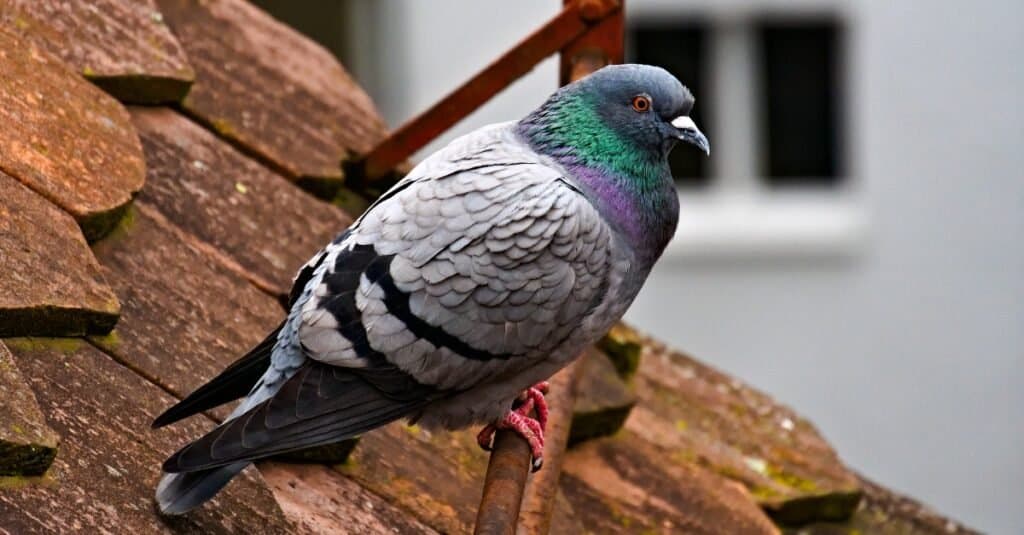
The Rock Dove (pigeon) can travel as fast as 148.9 km/h, which is around 92.5 mph.
©iStock.com/Christian Sturzenegger
Columbidae is the family to which the Rock dove (pigeon) belongs. It can travel as fast as 148.9 km/h, which is around 92.5 mph. Both domesticated and wild pigeons can trace their lineage back to the original, wild rock dove. It is currently confined to secluded, rocky places.
Spur-Winged Goose
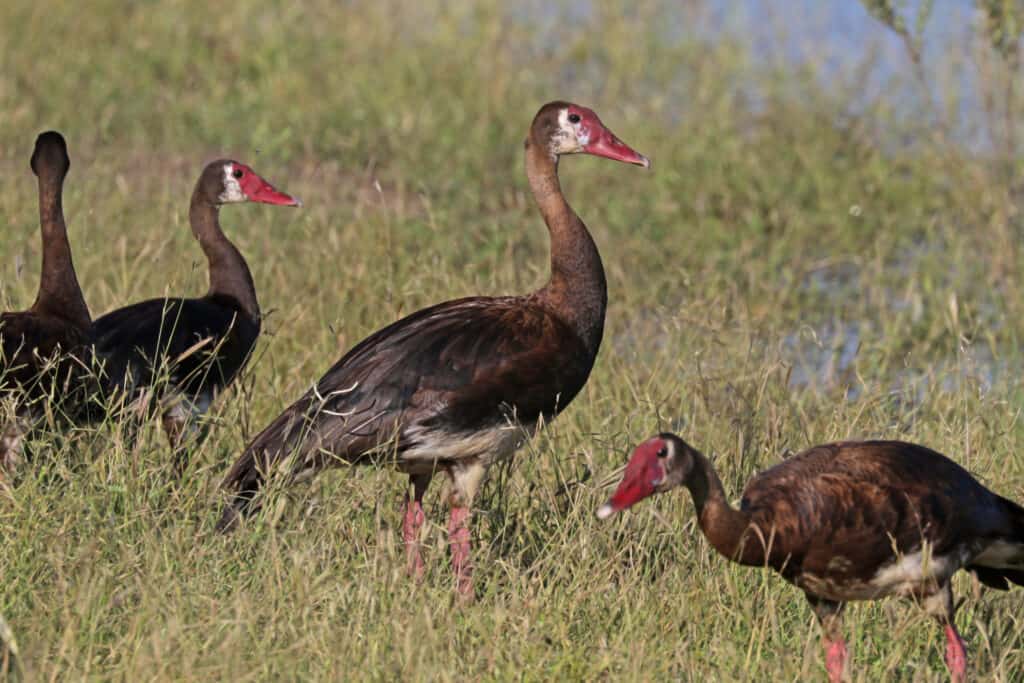
This impressive bird can reach a top speed of 88 miles per hour!
The Spur-Winged Goose is the largest and fastest-flying member of the goose family. It is closely related to the duck. The Spur-winged Goose is native to Africa’s wetlands. Spur Winged Geese typically range in length from 34 to 40 inches. This impressive bird can reach a top speed of 88 miles per hour!
Gyrfalcon
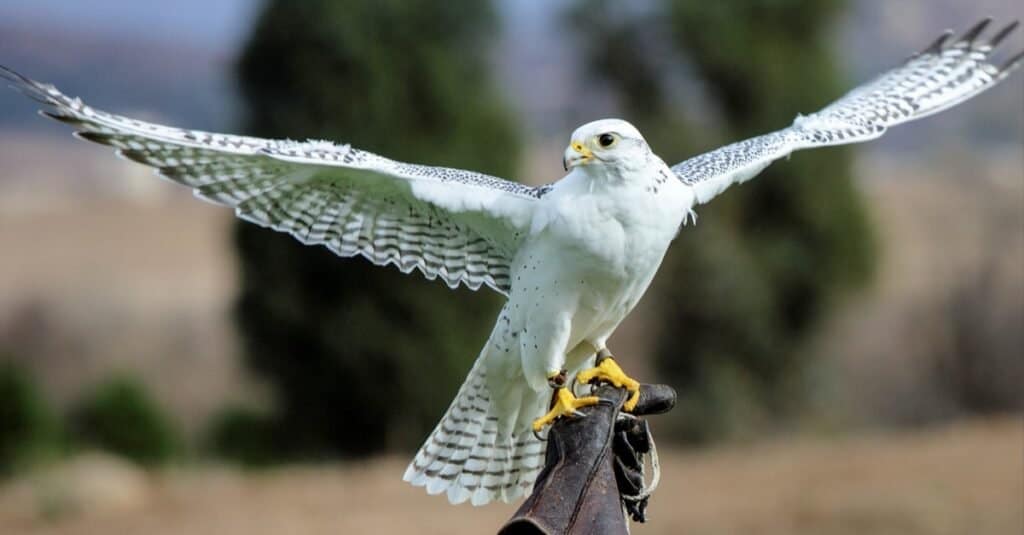
An Arctic Gyrfalcon on a gloved hand its spreading wings. Gyrfalcons can fly at very high altitudes where only eagles can fly as well.
©John Hancock/Shutterstock.com
The gyrfalcon, also known as the Falco rusticolus, is the largest species of falcon. As they dive, gyrfalcons can reach speeds of up to 322 kilometers per hour or 200 miles per hour! However, they prefer level-powered flight and rarely swoop on their prey. Their regular flight speeds typically do not exceed 50 mph or 80 kilometers per hour. Still quite an astounding range!
Grey-Headed Albatross
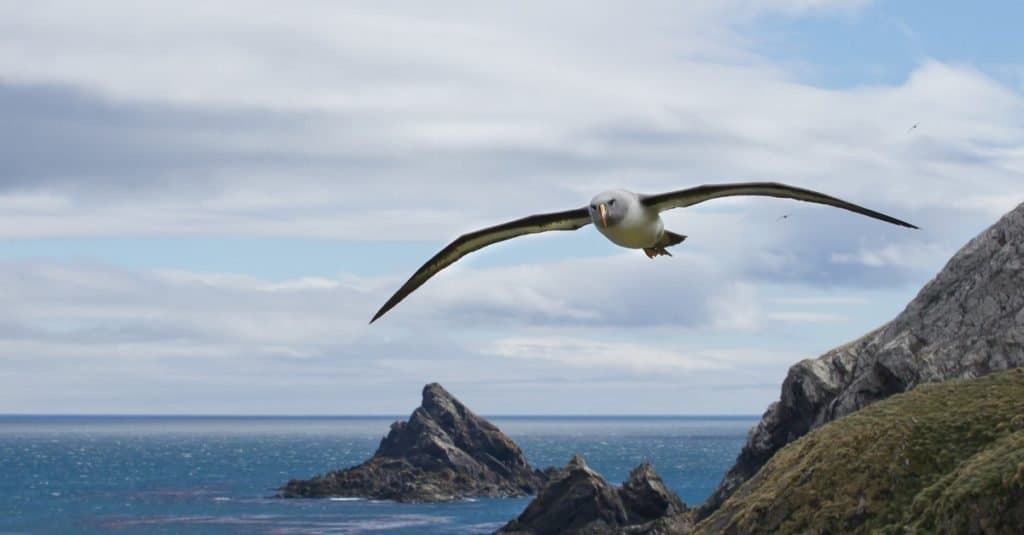
Grey-headed
Albatross
has been reported to have reached 127 km/h, or 78.9 mph.
©MZPHOTO.CZ/Shutterstock.com
Large seabirds belonging to the albatross family include the grey-headed albatross or Thalassarche Chrysostom. They are also known as the grey-headed mollymawk. The average estimated groundspeed reported for a satellite-tagged grey-headed albatross reached 127 km/h, or 78.9 mph in a 2004 paper published by research teams working in the sub-Antarctic.
Where Do Cheetahs Live?
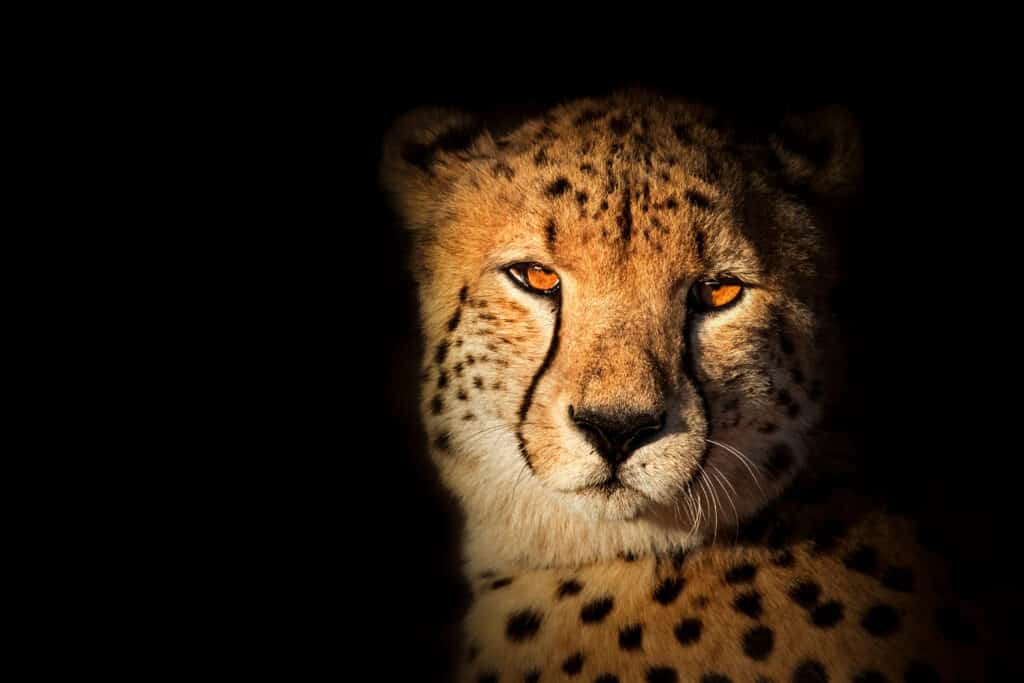
Cheetahs prefer open grasslands and even arid areas and can be found in Eastern and Southern
Africa
, as well as the Middle East
©Henrico Muller/Shutterstock.com
Cheetahs are native to Africa and have a small population in Iran. They can be found in a variety of habitats, including savannas, grasslands, and semi-desert regions.
In Africa, they are found mainly in the savannas of the Serengeti, Kalahari, and the savannas of Ethiopia, and South Africa. While in Iran, the Asiatic cheetah is found in the central desert regions and the Kavir desert.
They are also found in some national parks and wildlife preserves in these regions. As the cheetah population has been declining due to habitat loss, human-wildlife conflict, and poaching, they are now listed as vulnerable by IUCN.
In Conclusion
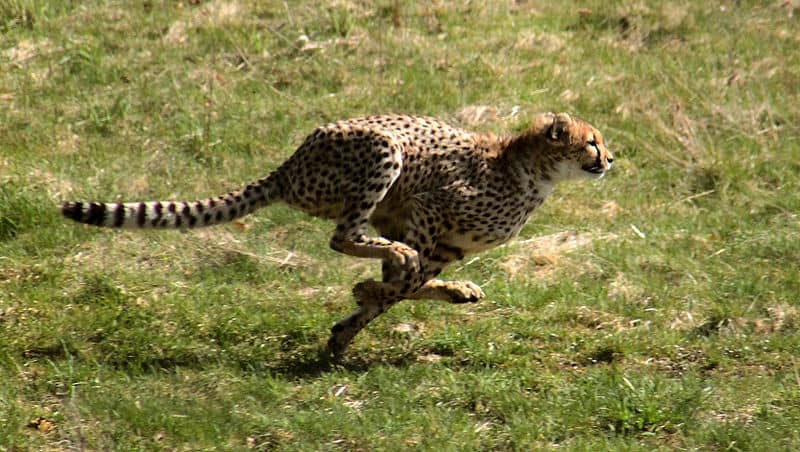
Cheetah chasing
its prey.
©Malene Thyssen / Creative Commons – Original
As you can see, only birds can outpace a cheetah. When diving, the peregrine falcon may reach speeds of up to 242 mph, making it both the fastest bird and the fastest animal. Birds’ velocities in flight are more nuanced than earlier studies have shown. Birds, according to studies, use a variety of techniques, each of which is basic yet effective, to regulate their airspeed and account for the effects of a tailwind, headwind, or sidewind. They are also able to reach higher speeds because of the thinner air at certain altitudes. Interesting, to say the least!
Summary of the 10 Animals Faster Than a Cheetah
| Rank | Faster Animals than A Cheetah | Speed |
|---|---|---|
| 1 | Peregrine Falcon | 242 mph |
| 2 | Golden Eagle | 150–200 mph |
| 3 | White-Throated Needletail Swift | 105 mph |
| 4 | Eurasian Hobby | 100 mph |
| 5 | Mexican Free-Tailed Bat | 100 mph |
| 6 | Frigatebird | 95 mph |
| 7 | Rock Dove (Pigeon) | 92.5 mph |
| 8 | Spur-Winged Goose | 88 mph |
| 9 | Gyrfalcon | 80 mph |
| 10 | Grey-Headed Albatross | 79 mph |
What is the Second Fastest Animal After a Cheetah?
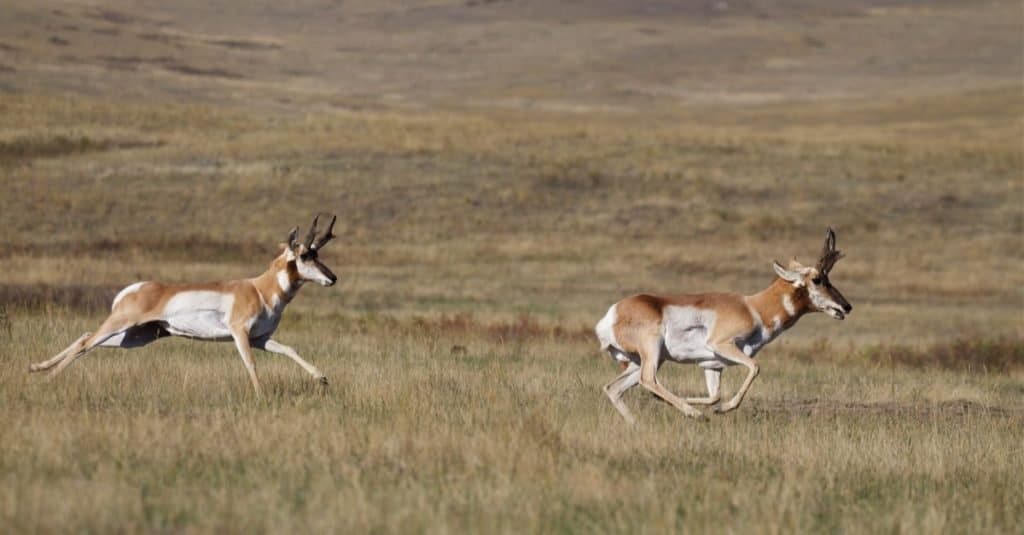
The Pronghorn
Antelope
,
Antilocapra americana, is the fastest mammal in North America.
©Tom Reichner/Shutterstock.com
From childhood, we all know that the cheetah is the world’s fastest land animal. Hands down, nothing beats the cheetah’s top speed except for a bird or bat dive-bombing their prey. They have evolved to be sprinting machines in order to catch their food.
But did you know that the pronghorn is a very close runner-up for the record of fastest? That’s right, the pronghorn antelope clocks in around 60 miles per hour for its top land speed.
While that speed for the antelope is extremely fast, it actually throws a wrench into the cheetah’s undisputed recorded because the pronghorn antelope can absolutely maintain those types of speeds for much longer than the big cats can.
Couple that kind of speed with a very keen eyesight that can see movement up to 4 miles away, it is really tough for any predator to get the drop on a pronghorn and take them down!
Honorable Mention: Other Fast Animals
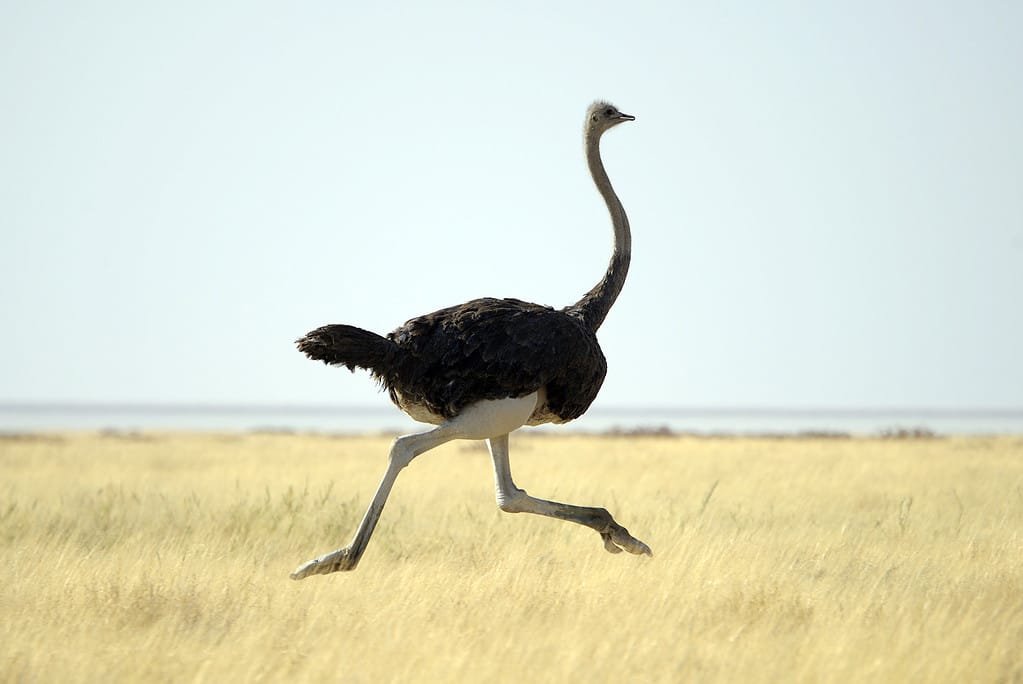
Out of the nine species of identified ostriches, only two remain.
©JohnCarnemolla/iStock via Getty Images
They may not be as fast as a cheetah, and they certainly don’t come close to the impressive speed of the peregrine falcon but these animals are still impressive with their speed.
- Black Marlin (Istiompax indica) – this marine animal is the second-fastest fish in the ocean, next to the sailfish. Found in tropical and subtropical areas of the Indian and Pacific Oceans, this fish can swim at an impressive 30 miles per hour. Although there are unconfirmed reports of these fish swimming as fast as 82 miles per hour it is most likely that they are closer to the reported speeds of 30 mph.
- Sailfish (Istiophorus) – there are two extant species of sailfish, which are found in the Western and Eastern parts of the Atlantic Ocean. While they have been found in the Mediterranean Sea, they are not common in this region. Reigning supreme as the fastest fish in the ocean, this fish clocks in at remarkable speeds of more than 68 miles per hour.
- Ostrich (Struthio)– there are two species of ostrich and these animals are not only the heaviest living birds but are also the birds that lay the largest eggs of any bird species on Earth. They may be flightless but they use their impressive wings to steer themselves when they run at impressive high speeds of up to 43 miles per hour. They are endemic to Africa but are now found throughout the world.
Thank you for reading! Have some feedback for us? Contact the AZ Animals editorial team.

